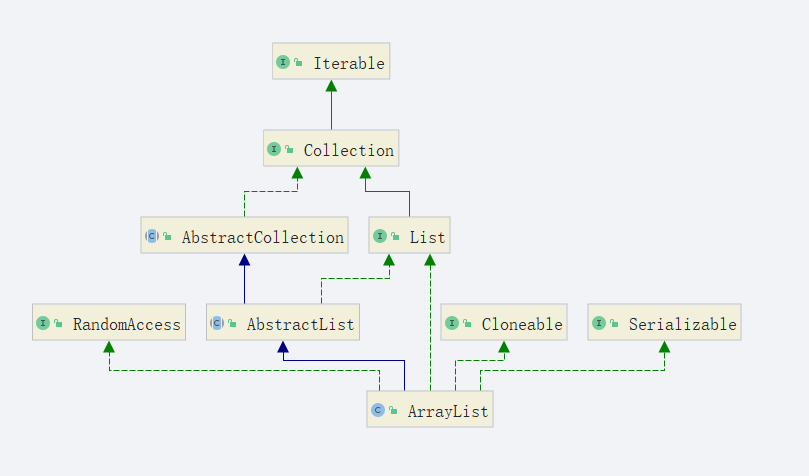介绍
ArrayList是一个动态可调整大小的数组列表。内部是基于数组实现的,大小会自动增长,支持随机访问。
public class ArrayList<E> extends AbstractList<E>implements List<E>, RandomAccess, Cloneable, java.io.Serializable
类图如下:
数据结构
静态常量
可以看到数组的大小默认为10
/*** Default initial capacity.*/private static final int DEFAULT_CAPACITY = 10;/*** Shared empty array instance used for empty instances.*/private static final Object[] EMPTY_ELEMENTDATA = {};/*** Shared empty array instance used for default sized empty instances. We* distinguish this from EMPTY_ELEMENTDATA to know how much to inflate when* first element is added.*/private static final Object[] DEFAULTCAPACITY_EMPTY_ELEMENTDATA = {};/*** 分配的数组的最大大小。 尝试分配更大的数组可能会导致 OutOfMemoryError**/private static final int MAX_ARRAY_SIZE = Integer.MAX_VALUE - 8;
成员变量
elementData存储了实际的元素,transient修饰符保证他不被序列化,size是数组中元素的个数。
/*** The array buffer into which the elements of the ArrayList are stored.* The capacity of the ArrayList is the length of this array buffer. Any* empty ArrayList with elementData == DEFAULTCAPACITY_EMPTY_ELEMENTDATA* will be expanded to DEFAULT_CAPACITY when the first element is added.*/transient Object[] elementData; // non-private to simplify nested class access/*** The size of the ArrayList (the number of elements it contains).** @serial*/private int size;
构造方法
构造方法根据指定的大小初始化elementData数组,注意传0和不传是不一样的,
传0会初始化为EMPTY_ELEMENTDATA,不传初始化为DEFAULTCAPACITY_EMPTY_ELEMENTDATA
public ArrayList(int initialCapacity) {if (initialCapacity > 0) {this.elementData = new Object[initialCapacity];} else if (initialCapacity == 0) {this.elementData = EMPTY_ELEMENTDATA;} else {throw new IllegalArgumentException("Illegal Capacity: "+initialCapacity);}}public ArrayList() {this.elementData = DEFAULTCAPACITY_EMPTY_ELEMENTDATA;}
添加元素 & 扩容 add(E e)
添加元素时使用 ensureCapacityInternal() 方法来保证容量足够,如果不够时,需要使用 grow() 方法进行扩容,新容量的大小为 oldCapacity + (oldCapacity >> 1),即 oldCapacity+oldCapacity/2。其中 oldCapacity >> 1 需要取整,所以新容量大约是旧容量的 1.5 倍左右。(oldCapacity 为偶数就是 1.5 倍,为奇数就是 1.5 倍 - 0.5 5 + 2.5
扩容操作需要调用 Arrays.copyOf() 把原数组整个复制到新数组中,这个操作代价很高,因此最好在创建 ArrayList 对象时就指定大概的容量大小,减少扩容操作的次数。
public boolean add(E e) {// 保证容量大小必须大于等于size + 1ensureCapacityInternal(size + 1); // Increments modCount!!// 赋值elementData[size++] = e;return true;}private void ensureCapacityInternal(int minCapacity) {// 数组为空,minCapacity从DEFAULT_CAPACITY(10)和minCapacity取最大值if (elementData == DEFAULTCAPACITY_EMPTY_ELEMENTDATA) {minCapacity = Math.max(DEFAULT_CAPACITY, minCapacity);}// 保证容量大小至少有minCapacity个ensureExplicitCapacity(minCapacity);}private void ensureExplicitCapacity(int minCapacity) {modCount++;// overflow-conscious code// 最小容量 - 当前数组长度 > 0,说明当前数组大小不够,需要扩容,调用grow函数if (minCapacity - elementData.length > 0)grow(minCapacity);}// 扩容private void grow(int minCapacity) {// overflow-conscious code// 旧数组的长度int oldCapacity = elementData.length;// 新数组长度为旧数组的长度 * 1.5// 如果旧数组是奇数,最低位会丢失,等同于oldCapacity + (oldCapacity-1) >> 1int newCapacity = oldCapacity + (oldCapacity >> 1);// 判断newCapacity < minCapacity,说明扩容一次后容量达不到minCapacityif (newCapacity - minCapacity < 0)// newCapacity赋值为minCapacitynewCapacity = minCapacity;// 超过最大分配数组大小if (newCapacity - MAX_ARRAY_SIZE > 0)newCapacity = hugeCapacity(minCapacity);// minCapacity is usually close to size, so this is a win:// 数组所有元素复制到新数组中,并赋值给elementDataelementData = Arrays.copyOf(elementData, newCapacity);}private static int hugeCapacity(int minCapacity) {if (minCapacity < 0) // overflowthrow new OutOfMemoryError();// 如果超过MAX_ARRAY_SIZE 赋值为Integer.MAX_VALUEreturn (minCapacity > MAX_ARRAY_SIZE) ?Integer.MAX_VALUE :MAX_ARRAY_SIZE;}Arrays.copyOf:public static <T> T[] copyOf(T[] original, int newLength) {// 获取数组的类型,复制指定长度的元素return (T[]) copyOf(original, newLength, original.getClass());}public static <T,U> T[] copyOf(U[] original, int newLength,Class<? extends T[]> newType) {@SuppressWarnings("unchecked")// 创建一个空的指定类型的数组,T[] copy = ((Object)newType == (Object)Object[].class)? (T[]) new Object[newLength]: (T[]) Array.newInstance(newType.getComponentType(), newLength);// 从original数值的0下标开始复制到copy数组的0下标处进行复制,复制的个数是newLengthSystem.arraycopy(original, 0, copy, 0,Math.min(original.length, newLength));return copy;}
通过下标获取元素 get(int index)
public E get(int index) {// 下标范围检查rangeCheck(index);// 通过数组下标直接获取元素return elementData(index);}private void rangeCheck(int index) {// 下标超过size,会有自定义提示,Index: {index}, Size: {size}// 如果下标是负数,数组本身也会抛出IndexOutOfBoundsExceptionif (index >= size)throw new IndexOutOfBoundsException(outOfBoundsMsg(index));}E elementData(int index) {return (E) elementData[index];}
根据index移除元素 remove(int index)
// 根据下标移除元素public E remove(int index) {// 下标范围检查rangeCheck(index);modCount++;// 下标取值E oldValue = elementData(index);// 移动元素的数量,index后面的元素的个数// 因为index从0开始,所有index后面元素数量应该是size - (index + 1) = size -index -1int numMoved = size - index - 1;if (numMoved > 0)// 下标从index之后的所有元素全部往前移动一位System.arraycopy(elementData, index+1, elementData, index,numMoved);// 移除末尾下标位置元素elementData[--size] = null; // clear to let GC do its work// 返回目标的旧值return oldValue;}private void rangeCheck(int index) {if (index >= size)throw new IndexOutOfBoundsException(outOfBoundsMsg(index));}@SuppressWarnings("unchecked")E elementData(int index) {return (E) elementData[index];}System.arraycopy:/*** src – 源数组。* srcPos – 源数组中的起始位置。* dest – 目标数组。* destPos – 目标数据中的起始位置。* length – 要复制的数组元素的数量。*/public static native void arraycopy(Object src, int srcPos,Object dest, int destPos,int length);
根据object移除元素 remove(Object o)
public boolean remove(Object o) {// 元素为nullif (o == null) {for (int index = 0; index < size; index++)// 遍历移除第一个值为null的元素if (elementData[index] == null) {fastRemove(index);return true;}} else {for (int index = 0; index < size; index++)// 遍历移除第一个equals相等的元素if (o.equals(elementData[index])) {fastRemove(index);return true;}}return false;}/** Private remove method that skips bounds checking and does not* return the value removed.*/private void fastRemove(int index) {modCount++;// remove后需要移动的元素个数int numMoved = size - index - 1;if (numMoved > 0)// index之后的所有元素向前移动一位System.arraycopy(elementData, index+1, elementData, index,numMoved);// 末尾下标元素赋值为nullelementData[--size] = null; // clear to let GC do its work}
这里只有一个关键点,remove(Object o)方法只会按顺序移除第一个equals的元素,如果equals有匹配多个元素话,则只会移除第一个。

